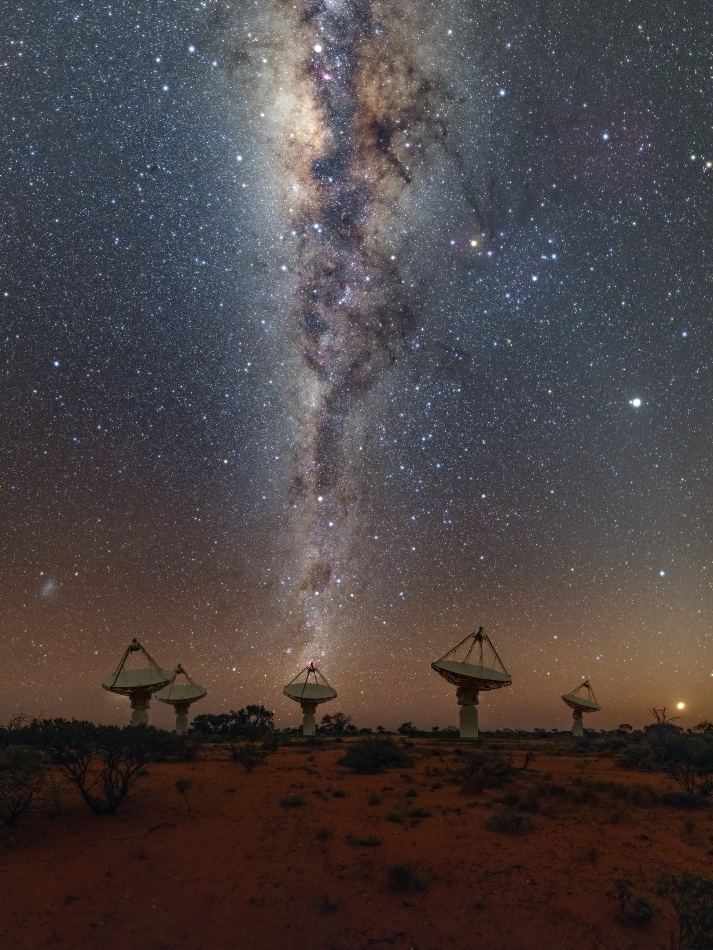Jun 28 2019
For the first time, the exact location of a powerful one-off burst of cosmic radio waves has been established by an Australian-led international team of astronomers.
 The Milky Way galaxy stretches above the core group of CSIRO’s Australian Square Kilometre Array Pathfinder (ASKAP) radio telescope. (Image credit: CSIRO, Alex Cherney)
The Milky Way galaxy stretches above the core group of CSIRO’s Australian Square Kilometre Array Pathfinder (ASKAP) radio telescope. (Image credit: CSIRO, Alex Cherney)
This breakthrough finding was made with CSIRO’s latest Australian Square Kilometer Array Pathfinder (ASKAP) radio telescope installed in Western Australia.
Three of the world’s largest optical telescopes—Gemini South, Keck, and the very Large Telescope of the European Southern Observatory—were used to image the galaxy from which the burst originated. The results of the study have been recently reported online by the journal Science.
This is the big breakthrough that the field has been waiting for since astronomers discovered fast radio bursts in 2007.
Dr Keith Bannister, Lead Author, CSIRO
Since the past 12 years, a global hunt has successfully captured 85 of these bursts. While most of these bursts have been “one-offs”, some are “repeaters” that recur in the same spot. Earlier in 2017, astronomers discovered a home galaxy of the repeater but it had been relatively difficult to localize a one-off burst.
Although there are fast radio bursts, they can last less than a millisecond, thus making it hard to precisely establish where exactly they have come from.
In this regard, Dr Bannister’s group came up with a novel technology to freeze and save the ASKAP data within a second after a burst reaches the telescope.
This new technology was utilized to specify the exact location of FRB 180924 to its home galaxy, that is, DES J214425.25−405400.81. The researchers created a high-resolution map, which showed that the burst emerged in the peripheries of a Milky Way-sized galaxy approximately 3.6 billion light-years away.
If we were to stand on the Moon and look down at the Earth with this precision, we would be able to tell not only which city the burst came from, but which postcode—and even which city block.
Dr Keith Bannister, Lead Author, CSIRO
ASKAP is essentially an array of many dish antennas. The burst travels a varied distance to each dish and reaches them all at a somewhat different time.
“From these tiny time differences—just a fraction of a billionth of a second—we identified the burst's home galaxy and even its exact starting point, 13,000 light-years out from the galaxy’s centre in the galactic suburbs,” stated team member Dr Adam Deller of Swinburne University of Technology.
To figure out more about the home galaxy, the group used the European Southern Observatory’s 8-m Very Large Telescope in Chile to image it and then used the 8-m Gemini South telescope in Chile and the 10-m Keck telescope in Hawai to measure its distance.
“Repeater”—the only earlier localized burst—is emerging from an extremely small galaxy that is creating plenty of stars.
The burst we localised and its host galaxy look nothing like the 'repeater' and its host. It comes from a massive galaxy that is forming relatively few stars. This suggests that fast radio bursts can be produced in a variety of environments, or that the seemingly one-off bursts detected so far by ASKAP are generated by a different mechanism to the repeater.
Dr Adam Deller, Team Member, Swinburne University of Technology
However, the cause of rapid radio bursts continues to be a mystery, but the potential to establish their actual location is a major step forward towards solving this puzzle.
Dr Jean-Pierre Macquart (Curtin University node of the International Centre for Radio Astronomy Research (ICRAR)) is a team member and an expert on utilizing fast radio bursts to examine the universe.
“These bursts are altered by the matter they encounter in space. Now we can pinpoint where they come from, we can use them to measure the amount of matter in intergalactic space, informed Dr Macquart.
This might expose the material that astronomers have strived to locate for many years.
Radio burst’s localization was performed as part of a project using ASKAP known as Commensal Real-time ASKAP Fast Transients (CRAFT) that is jointly headed by Dr Macquart, Dr Bannister, and Dr Ryan Shannon of Swinburne University of Technology.
The observations were carried out by CSIRO’s Dr Shivani Bhandari and Dr Shannon, who were the first to detect the burst.
The optical observations were carried out by J. Xavier Prochaska (University of California Santa Cruz, USA), Stuart Ryder (Macquarie University, Australia), and Nicolas Tejos (Pontificia Universidad Catolica de Valparaiso, Chile).
ASKAP is a precursor to the future Square Kilometre Array telescope and is situated at CSIRO’s Murchison Radio-astronomy Observatory.
CSIRO acknowledges the Wajarri Yamaji as the traditional owners of the MRO site.